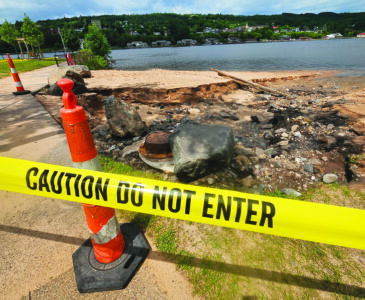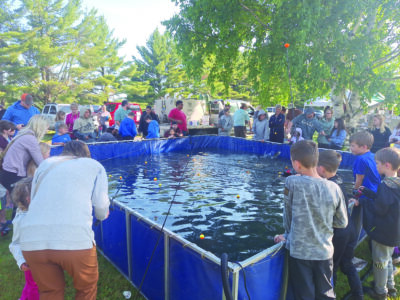Q&TLRR Locomotive No. 6 looks brand new

Graham Jaehnig/Daily Mining Gazette The fully cosmetically restored Quincy & Torch Lake Rail Road’s Baldwin Number 6 locomotive and tender, after an absence of some 45 years, is once again in the former Quincy Mining Company’s engine house.
FRANKLIN TOWNSHIP — A dedicated group of volunteers, led by Illinois resident Chuck Pomazal, is spending this week continuing restoration work at the Quincy & Torch Lake Railroad’s engine house, preparing a locomotive tender for restoration.
Pomazal, a retired civil engineer, and a dedicated crew of volunteers, returns to the engine yard twice a year to continue the ongoing restoration projects.
He said it all started about 15 years ago, with restoring the cab on one of two old Quincy engines that had been on display by the Quincy Mine Hoist Association’s hoist house since 1975
The Quincy Group of Dedicated Volunteers, it started about 15 years ago, restoring locomotives that had been on display up by the hoist building since 1975, sitting out in the weather. It started up there, he said, because the cab on the one locomotive was all rotted away and it was dangerous.
“We couldn’t let it deteriorate further,” said Pomazal, “so we went ahead and — I made new cab sides for it; we sandblasted and painted it.”
About that time, his group realized that the Q&TL RR’s Locomotive No. 6 was out in New Jersey — it had been hauled there in 1975 by the Pine Creek Railway. Their intention was restore it and use it on their excursion railroad, and once they got it out there, they realized it was too big of a project for them, and so they just parked it.
It turned out that the Pine Creek Railway did not own the locomotive, but had held only a 30-year lease on the engine. The son of the Quincy Mining Company’s last president, Rodney Propp, owned the engine, and as the lease was up, Propp was faced with three choices: sell it, scrap it, or donate it.
Pomazal said his group approached Propp, who then donated the engine to the Quincy Hoist Association. In 2009, Pomazal and a couple of friends went to New Jersey to prepare the engine to be trucked back to Hancock.
Once the engine was back at the Quincy and Torch Lake Railroad engine house, Pomazal hired T and L Trevarrow Painting, from Lake Linden to sandblast and primer paint the engine. Rustoleum donated 12 gallons of zinc-rich primer, Superior Sand and Gravel donated a pallet sandblast sand, Gundlach Construction loaned an air compressor.
Pomazal said relying on a Department of Transportation grant, the QMHA was able to stabilize the engine house, replacing the roof and doors. With that done, restoration began on the locomotive tender. With that completed, the engine was then rolled into the engine house for restoration.
To fund the restoration, Pomazal approached the QMHA with a proposal: If he wrote a book on the history of the Q&TL Railroad, with all proceeds going to the restoration fund, would they publish it? They agreed. Pomazal’s book, Rock Down, Coal Up: the Story of the Quincy & Torch Lake Railroad was published in 2014, and sales from it from it funded nearly all of the restoration project.
With Locomotive Number 6 restored, the next project was having the nearby water tank structure restored.
The locomotive was manufactured by the Baldwin Locomotive Works of Philadelphia, and was the first engine the Quincy company ordered new, to their specifications.
“It was referred to as ‘The Beast,” said Pomazal.
It was much more powerful than previous locomotive the company had owned, he said, and could haul 44 empty rock cars up the hill from the stamp mill in Mason, to the mine, whereas the other could haul 22.
To put the power of the engine into perspective, the total weight of a rock car loaded was 27 tons. The locomotive, on average, hauled 12 cars, for a total of 324 tons.
The Quincy Mining Company began construction on the Quincy and Torch Lake Railroad in the fall of 1888, to run from the mine, north of Hancock, to its stamp mill, at Mason, on Torch Lake, a distance of 6.5 miles. The new railroad began transporting mine rock to the new mill in 1890.





